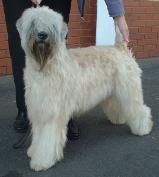
This is a placeholder text
Group text
by poseidon on 22 December 2008 - 00:12
Hello Bok,
I have no idea what happened. An error has occured when I tried to insert this article which I had copied and paste. I cannot seem to access the text area for your raised topic for discussion there.
Advice fro
by poseidon on 22 December 2008 - 00:12
Advice from canine concepts:
Dogs like to feel safe and secure when sleeping and somewhere they can be alone. A dog crate is able to provid
by poseidon on 22 December 2008 - 00:12
provide this safe haven.
Why use a dog crate / cage anyway?
A crate helps address many of the problems that cause stress and anxiety to pet owners. They serve a useful purpose to prevent (and rectify) problems associated with destructive behaviour and fear of strangers or other types
by poseidon on 22 December 2008 - 00:12
other types of people. They help with house training, with visitors who are afraid of dogs and of course when travelling with your dog.
Where should I put the dog crate?
The best places for a crate or cage are in the corner of rooms, away from too much heat and cold drafts. Dogs like to be near their
by poseidon on 22 December 2008 - 00:12
Dogs like to be near their pack (which is you), so locate the crate where your dog can see and hear you. It's a good idea for the crate to be your dog's only bed.
What do I look for in a dog crate / cage?
A dog crate is a usually a rectangular enclosure con
by poseidon on 22 December 2008 - 00:12
A dog crate is a usually a rectangular enclosure constructed of wire, plastic, canvas or even wood. Some people prefer to start out with a wire crate as these are less prone to being chewed in the early days of crate training.
by poseidon on 22 December 2008 - 00:12
Whichever type of dog crate / cage you get, they should be large enough to allow your dog to stretch out flat on his side without being cramped and to sit up without hitting their head on the top. Also remember that a dog crate that is too large defeats the purpose of providing security and promoting bowel control. If you are purchasing a crate that is large enough for your dog when fully grown, block off part of it so that your dog feels snug and secure (some manufacturers sell optional partitions for their crates). Make them as comfortable as possible with washable blankets.
It is also a good idea to have a cover to darken the inside of the dog crate, this helps settle your dog and make it less likely for him to be disturbed by distraction outside. Covers can either be a blanket or a purpose-made fitted cover. Whichever you choose, make sure your dog’s crate has plenty of ventilation and is not in direct sunlight
by poseidon on 22 December 2008 - 00:12
When should crate / cage training start?
It is best to start crate training when your dog is still a puppy, that's not to say you cannot train an older dog, it just takes a little longer.
How long should I use a crate / cage?
Plan to use the crate until the puppy is ten or twelve months old, well past the chewing stage. You will not need to continue crating once your dog becomes an adult (and is trustworthy), but your dog will probably enjoy the continued use of the crate as its own special place. If you decide not to keep the crate, slowly wean your dog off it.
by poseidon on 22 December 2008 - 00:12
continued use of the crate as its own special place. If you decide not to keep the crate, slowly wean your dog off it.
Crates are not just for puppies, they are also a valuable tool to help solve behavioural problems in adolescent and more mature dogs. Acclimatising older dogs is a lot harder and will require more patience. If you plan to travel a lot with your dog, it may well be worth continued use of the crate.
How d
by poseidon on 22 December 2008 - 00:12
How do I acclimatise my dog to the crate / cage?
You can't lock you dog in a crate and just expect the whole concept to work - it won't. You will need time and patience to introduce the crate to successfully ensure your dog sees it as its home and special place. Here are a few guidelines:
- Start by leaving the crate door open, and place all your dog’s toys just inside the door. Hence if they want a toy they will have to climb into the crate a bit and retrieve it. You can also use special treats as a further encouragement to enter the crate. Day by day, move the toys or treats further back. It will only take a day or two before your dog starts to go into the crate to lie down. <
Contact information Disclaimer Privacy Statement Copyright Information Terms of Service Cookie policy ↑ Back to top




